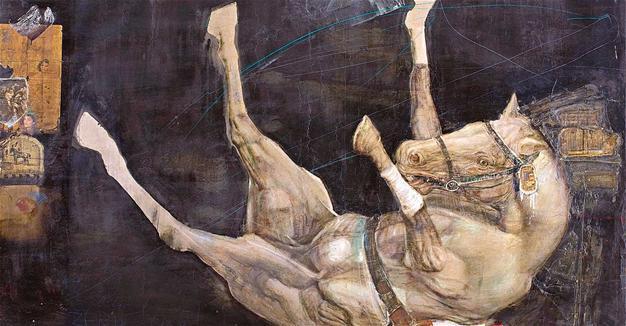Bosnian artist Mersad Berber at Istanbul’s Pera Museum
ISTANBUL

Istanbul’s Pera Museum is presenting “Mersad Berber: An Allegory of Bosnia,” an exhibition exploring one of the leading representatives of Bosnian-Herzegovinian art in the second half of the 20th century.
Inspired by the masters of European fine arts from the Renaissance to Art Nouveau, Berber’s work (1940-2012) infuses expressive powers and intricate talent.
The show, curated by Aida Abadžić Hodžić, Bosnia-Herzegovina’s leading art historian, and Edward Lucie-Smith as the exhibition’s advisor, showcases the artist’s impressions with the likes of Velázquez, Ingres, and Klimt, as well as Yugoslavian painters Bukovac and Jurkić.
A wide array of Berber’s works range from the deep, opaque whites influenced by his travels to Bosnia’s fairy-tale landscapes to the dark and terrible pits of Srebrenica.
Known for his large canvases and mixed technique, Berber differs from the European masters from whom he derives his inspiration by virtue of his unique themes and innovative approach to composition. Hodžić describes Berber, who reflects in his paintings the full scale of the complexity of his country’s multi-layered cultural history, as “the pioneer of the generation of young graphic artists who opened up the local art scene to global trends.”
An impressive introduction to the art sceneBerber was a student at the Ljubljana Fine Arts Academy in the early 1960s when he received the Prešeren Award. His works were first exhibited at the Ljubljana Graphic Arts Biennial in 1961, one of the prestigious art events of the period, along with works by the leading graphic artists of the world. Berber’s early drawing and prints demonstrated the influence of the academy in terms of technique, and his interest in expressing cultural traditions using a modern visual expression in terms of theme.
With his unique talent that lets him forge connections between different cultures and traditions, and his intelligence that penetrates the depths of historical experience, Berber brought together styles spanning the range from antiquity to the modern era in a manner that was very much his own. This style continued to be seen in his works in the 1990s, where he combined references to the great masters of European art with old photographs and postcards of Bosnia.
In his works, Berber depicted tragic events of wars in the 1990s, especially in Bosnia-Herzegovina, which reached a nadir with the Srebrenica massacre.
The artist regarded the tragedy at Srebrenica as “the big, ancient, sacred theme of hymns” and labored for years to depict it in his works, collecting newspaper photographs, documents, forensic reports, video recordings, and books, and visiting Srebrenica and Potočari countless times. These works became elegies not only for those who had died, but also for the death of multiculturalism, which had survived in the Balkans for centuries despite all ethnic and religious animosities.
The central metaphor in most of Berber’s works is the horse figure, a key symbolic animal which has many different meanings and representations in various cultures. In Berber’s own words, this figure is not that of an impressive horse, it is a toiling packhorse from the mountains of Bosnia, having deep ties to all aspects of life, signifying hard labor and marriages, funerals, and wars. The expressive capacity of this horse, its suffering, and its imperfect beauty represent the biography of Berber’s people.
The exhibition at Pera Museum in Istanbul’s Beyoğlu district can be seen through May 7.
 Istanbul’s Pera Museum is presenting “Mersad Berber: An Allegory of Bosnia,” an exhibition exploring one of the leading representatives of Bosnian-Herzegovinian art in the second half of the 20th century.
Istanbul’s Pera Museum is presenting “Mersad Berber: An Allegory of Bosnia,” an exhibition exploring one of the leading representatives of Bosnian-Herzegovinian art in the second half of the 20th century.